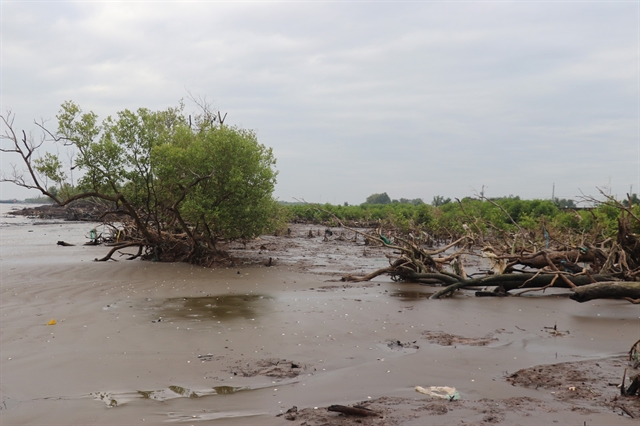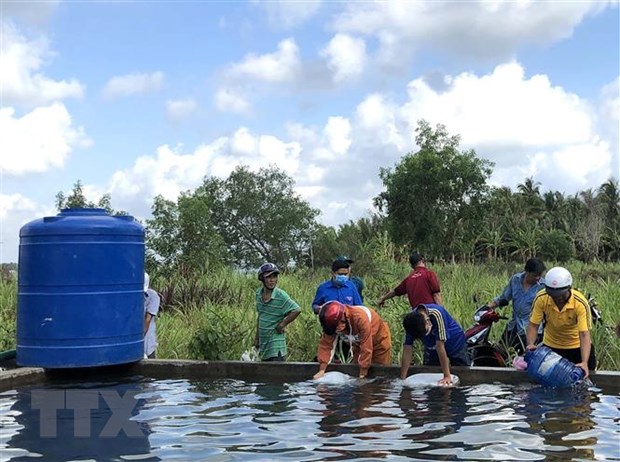 Environment
Environment


|
| Tanks of water from Sài Gòn Water Supply Company were carried to the Mekong Delta province of Bến Tre to supply people who face water shortages due to drought and saline intrusion. — VNA/VNS Photo |
LONG AN — Mekong Delta provinces have experienced the most severe drought and saline intrusion ever in the dry season 2019-2020 but the negative impacts on agriculture production and daily life were minimised significantly thanks to effective measures, a top official has said.
Minister of Agriculture and Rural Development Nguyễn Xuân Cường made the statement at a meeting held in the Mekong Delta province of Long An on Saturday about drought and saline intrusion prevention and control.
He said that thanks to what had been done to fight drought and salinity intrusion in the province, Việt Nam could learn good lessons for dealing with the extreme weather in the future.
Cường applauded the timely forecasting of salinity intrusion that helped agencies and farmers restructure agricultural production to match available water volume.
The Government, ministries and agencies effectively instructed localities and agencies to develop plans to tackle drought, saltwater intrusion and water shortages.
“This year, we identified challenges posed by droughts and saltwater intrusion to the Mekong Delta early,” Cường said, adding that as soon as September 2019, Prime Minister Nguyễn Xuân Phúc met with leaders of 13 Mekong Delta provinces to discuss the issue.
The minister recalled the saline intrusion in 2016 which was described as the worst in the region in 100 years which offered both authorities and people experiences to better deal with this year’s incidents.
Saline intrusion in 2016 lasted about two months, and only two communes in Bến Tre Province were not affected while this year, the saline intrusion has already lasted five months and the whole Mekong Delta region has been submerged under water.
“Groups of measures were taken,” he said.
Works to store water and prevent saline intrusion were built and completed on time.
Cultivation areas were zoned, reduced and crops and cultivation times were changed so the areas affected by drought or saline intrusion was reduced.
The dredging of canals, ponds or wells and the construction of dams, pumping stations to control saline intrusion helped save nearly 400,000 ha of farming land.
Cường said because people were equipped with a better understanding of the risks, development and impacts of saline intrusion, they became more active in responding and strictly followed agencies’ recommendations.
People stored water during the previous rainy season and in areas that faced water shortages, water was carried to every household, Cường said.
According to the Directorate of Water Resources, the dry season 2019-2020 hit the Mekong Delta region in the middle of November 2019, about a month earlier than in previous years, while it lasted twice as long as the dry season in 2016.
Droughts and salinity remained severe during the dry season, with salinity levels in the Cửa Tiểu, Cửa Đại and Hàm Luông rivers remained high from February to May.
According to the Cultivation Department under the ministry, saline intrusion directly hit 10 out of 13 Mekong Delta provinces.
About 41,900 ha or 2.7 per cent of the total winter-spring rice crop in the region was damaged by the saline intrusion, of which, Trà Vinh lost 14,300ha, Tiền Giang 4,500ha, Sóc Trăng 4,100ha, Kiên Giang 1,600ha, Long An 800ha and Cà Mau 600ha.
The lost crops were mainly planted after December 2019 as farmers did not take the advice of agencies.
About 6,650ha of orchards were affected by the droughts and saline intrusion.
More than 1,240ha of other crops were affected.
About 8,715ha of aquaculture production including fish and shrimp were affected, mostly in provinces of Tiền Giang, Bến Tre, Cà Mau, Bạc Liêu and Kiên Giang.
About 96,000 households had their water supply disrupted during the dry season due to droughts and saline water. Meanwhile, droughts and saline intrusion in the dry season 2015-2016 caused water shortages for about 210,000 households in the region though it lasted about two months. — VNS




